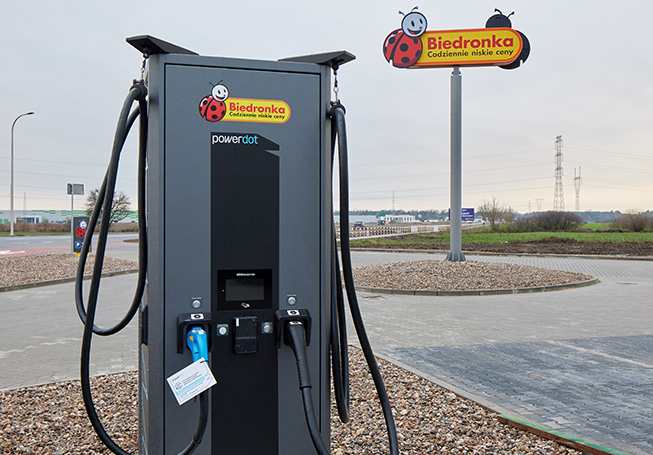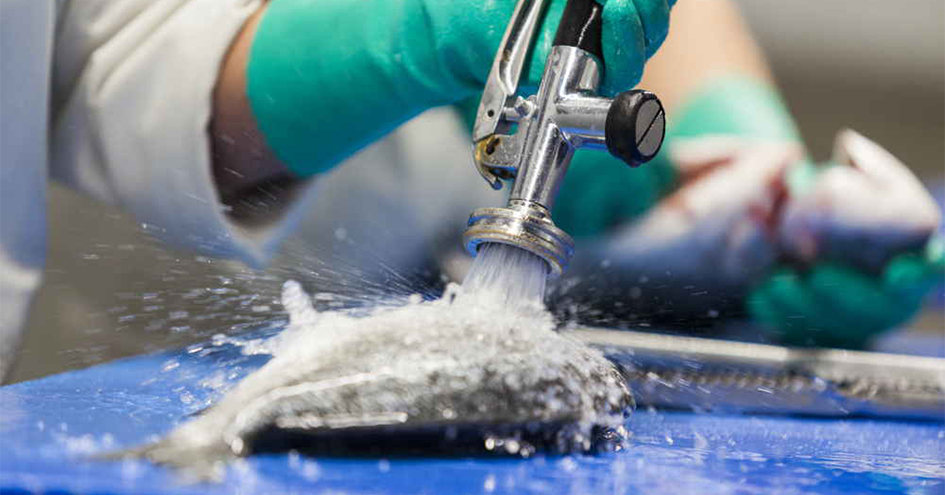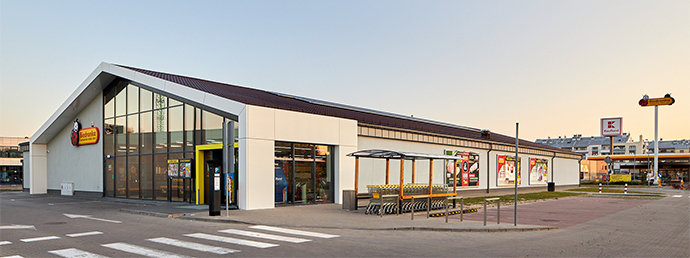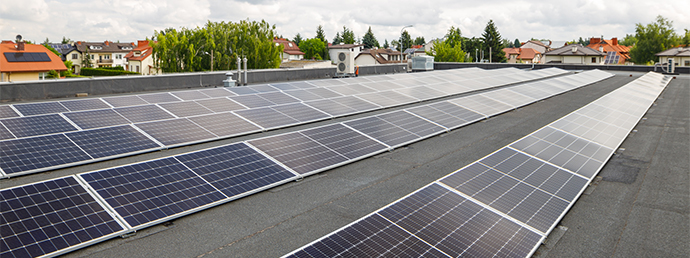Focused on reducing the impact of our activities on the use of resources and GHG emissions, we have implemented good practices in our own operations to curb the increase in water and energy consumption inherent in business expansion. The refurbishment and new store opening plan includes solutions such as:
- technologies for generating renewable energy;
- energy control and management systems;
- refrigeration technologies;
- freezers;
- efficient lighting;
- water saving systems, such as flow regulators, taps with timers, and rainwater harvesting for our irrigation systems and to wash equipment.
In 2023, we increased the number of stores with electric vehicle charging points to 215 at Pingo Doce, 5 at Recheio, and 210 at Biedronka, which supplied more than 12,000 gigajoules (GJ). In our fleet of light vehicles, 11% of the vehicles in Portugal and 1.5% in Poland were electric or plug-in hybrid vehicles. The investment made from 2017 in these measures, totalling 384 million euros, was recovered in a three-year period average and has avoided the emission of more than 780,000 tonnes of CO2e.


Raising employee awareness of waste recovery and the efficient use of water and energy has helped improve the environmental performance of our establishments. The “Water and Energy Consumption Management Teams” project, launched in 2011 in the Pingo Doce and Recheio stores, has helped to reduce water consumption by 508,000 m3 and energy consumption by 87 million kWh, corresponding to cumulative savings of over 10.7 million euros1. The actions of these teams at Pingo Doce are part of the “Todos pelo Ambiente” (Everyone for the Environment) initiative. In 2022, Biedronka launched the initiative “Dobra energia” (Good Energy), which included the development of a good practice handbook to save energy in stores, interactive training for all store employees, electricity consumption monitoring reports, and a dedicated chatbot to facilitate daily operations. By 2023, this project had reduced store electricity consumption by an average of 4%. The “Let’s Go Green” project, implemented in 2015 with the same goal, encompasses office buildings in Portugal, Poland and Colombia.
Water withdrawal and reuse
Total consumption (megalitres/million euros in sales) |
|
2023 |
|
2022 |
|
Δ 2023/2022 |
||||
|---|---|---|---|---|---|---|---|---|---|---|
Overall specific value |
|
0.212 |
|
*0.232 |
|
-8.6% |
||||
Specific value (Distribution) |
|
0.106 |
|
0.123 |
|
-13.8% |
||||
Specific value (Agribusiness) |
|
28.711 |
|
*30.848 |
|
-6.9% |
||||
|
||||||||||
Total withdrawal (megalitres) |
|
2023 |
|
2022 |
|
Δ 2023/2022 |
||||||
|---|---|---|---|---|---|---|---|---|---|---|---|---|
Water withdrawal by source1 |
|
6,500.4 |
|
*5,881.1 |
|
+10.5% |
||||||
Municipal and private supply system |
|
6,165.9 |
|
*5,590.0 |
|
+10.3% |
||||||
Groundwater |
|
316.4 |
|
272.8 |
|
+16.0% |
||||||
Surface water (including rainwater) |
|
18.1 |
|
18.3 |
|
-1.1% |
||||||
Water withdrawal by business unit |
|
|
|
|
|
|
||||||
Pingo Doce |
|
1,726.1 |
|
1,666.4 |
|
+3.6% |
||||||
Recheio |
|
88.6 |
|
93.2 |
|
-4.9% |
||||||
Biedronka |
|
941.0 |
|
956.3 |
|
-1.6% |
||||||
Hebe |
|
21.7 |
|
17.8 |
|
+21.9% |
||||||
Ara |
|
472.9 |
|
385.1 |
|
+22.8% |
||||||
JMA |
|
3,250.1 |
|
*2,762.3 |
|
+17.7% |
||||||
|
||||||||||||
Recycled water (megalitres) |
|
2023 |
|
2022 |
|
Δ 2023/2022 |
||||
|---|---|---|---|---|---|---|---|---|---|---|
Total recycled water1 |
|
2.4 |
|
2.6 |
|
-7.7% |
||||
|
||||||||||
We exceeded the goal of reducing the volume of water withdrawal in Distribution by 10% per million euros in sales by the end of 2023 compared to 2017, achieving a reduction of 38%.
In absolute terms, water withdrawal increased 10.5% compared to 2022, due mainly to the growth of the agrifood business and the increase in the number of Ara and Biedronka stores. As regards Jerónimo Martins Agro-Alimentar (JMA), the need to increase water consumption was due to high temperatures and meteorological drought in mainland Portugal, as well as the larger area used to cultivate cereals and pastures at Best Farmer, and the increase in the number of animals and the area used to establish pastures at Ovinos da Tapada.
Water withdrawal in Distribution increased 4.2%, in absolute terms, compared to 2022, due to the expansion of the store network (411 more stores compared to 2022), the increase in business at Recheio, and the growth of the takeaway and restaurant activity at Pingo Doce. The two central kitchens produced more, restaurant activity increased and the fresh food area was expanded, resulting in increased water consumption for preparing meals and washing tools and equipment.
More than 95% of the water we used for our activities came from municipal or private supply systems. Groundwater and surface water withdrawal accounts for the remaining 5%, for which we hold the required licences and is used for less demanding operations, such as irrigation and cooling systems.
In 2023, the specific value continued to decrease in Distribution activities, falling from 0.123 to 0.106 megalitres per million euros in sales.
In terms of water reuse, despite the slight reduction in the consumption of reclaimed water due to less rainfall in 2023 compared to 2022, we now also have a Recheio store with a water recycling programme, which joins four distribution centres (one in Portugal and three in Colombia) and two JMA farms that already were reusing water. The harvested water was used for cooling systems, irrigation, external truck washing, and livestock watering systems.
Water disposal
Total wastewater (megalitres) |
|
2023 |
|
2022 |
|
Δ 2023/2022 |
||||
|---|---|---|---|---|---|---|---|---|---|---|
Wastewater disposal by type of destination1 |
|
2,809.0 |
|
2,702.5 |
|
+3.9% |
||||
Municipal sewage |
|
2,757.2 |
|
2,641.7 |
|
+4.4% |
||||
Environment |
|
51.8 |
|
60.8 |
|
-14.8% |
||||
Wastewater disposal by business unit |
|
|
|
|
|
|
||||
Pingo Doce |
|
1,381.0 |
|
1,333.2 |
|
+3.6% |
||||
Recheio |
|
70.9 |
|
74.6 |
|
-5.0% |
||||
Biedronka |
|
752.8 |
|
765.1 |
|
-1.6% |
||||
Hebe |
|
17.4 |
|
14.2 |
|
+22.5% |
||||
Ara |
|
378.2 |
|
308.1 |
|
+22.8% |
||||
JMA |
|
208.7 |
|
207.3 |
|
+0.7% |
||||
|
||||||||||
Wastewater discharged directly into the natural environment is licensed in accordance with local laws and is properly treated in the places where it is generated before being discharged, accounting for 1.8% of the total volume of wastewater we generated (0.4 p.p. less than in 2022).

Water consumption
Total water consumed (megalitres) |
|
2023 |
|
2022 |
|
Δ 2023/2022 |
||||||
|---|---|---|---|---|---|---|---|---|---|---|---|---|
Water consumption by business unit |
|
3,691.4 |
|
*3,178.8 |
|
+16.1% |
||||||
Pingo Doce |
|
345.2 |
|
333.3 |
|
+3.6% |
||||||
Recheio |
|
17.7 |
|
18.6 |
|
-4.8% |
||||||
Biedronka |
|
188.2 |
|
191.3 |
|
-1.6% |
||||||
Hebe |
|
4.3 |
|
3.6 |
|
+19.4% |
||||||
Ara |
|
94.6 |
|
77.0 |
|
+22.9% |
||||||
JMA |
|
3,041.4 |
|
*2,555.0 |
|
+19.0% |
||||||
|
||||||||||||
Water stress
To determine the exposure of our activities to the risk of a shortage of drinking water, a water stress test per class (associated with water withdrawal) is conducted every year. To this end, the physical locations of the Companies are mapped and the World Resources Institute (WRI) “Aqueduct: Baseline Water Stress Class” model is followed.
|
|
Water withdrawal (megalitres) |
|
Water disposal (megalitres) |
||||
|---|---|---|---|---|---|---|---|---|
Water stress class |
|
Municipal and |
|
Groundwater and surface water |
|
Municipal |
|
Environment |
Total |
|
6,165.9 |
|
334.5 |
|
2,757.3 |
|
51.8 |
Low |
|
791.8 |
|
36.1 |
|
644.2 |
|
18.1 |
Low to medium |
|
255.3 |
|
120.6 |
|
226.8 |
|
31.1 |
Medium to high |
|
3,493.8 |
|
77.8 |
|
484.7 |
|
0.0 |
High |
|
296.9 |
|
48.5 |
|
270.9 |
|
0.0 |
Extremely high |
|
1,326.4 |
|
51.6 |
|
1,129.2 |
|
2.6 |
Drought |
|
0.0 |
|
0.0 |
|
0.0 |
|
0.0 |
No data |
|
1.7 |
|
0.0 |
|
1.4 |
|
0.0 |
This analysis shows that, in 2023, 27% of total water withdrawal (1,723 megalitres, 1,785 megalitres less than in 2022 as a result of an update to the Aqueduct model2) has an “extremely high” or “high” water stress level. In terms of water disposal, the volume for both risk levels is of 1,403 megalitres (50% of the total, 844 megalitres more than in 2022, due to the increased risk in Poland according to Aqueduct 4.0). To mitigate the risk of water shortage in our activities, we are:
- installing smart irrigation systems that adjust the amount of water based on soil water needs;
- installing flow regulators and automatic sensors;
- harvesting rainwater for later use;
- using regenerative agriculture techniques applied to the cultivation of cereal crops for cattle feed;
- incorporating non-graded products or by-products of the food industry3 into animal feed (because they have a high moisture content, these products reduce the animals’ need for water and their dependence on cereals);
- preventing deterioration of water quality by treating wastewater.
Water efficiency on JMA farms
To reduce water consumption, optimise production and increase the water resilience of JMA’s agricultural activities, the Companies in this business area invest in technologies such as:
- the installation of weather stations to quantify rainfall, wind direction and intensity, the number of hours of sunshine and degrees of heat to optimise irrigation needs;
- the installation of soil moisture sensors to measure the amount of water available for plants and to adjust irrigation according to the needs of each crop;
- the use of pivots with efficient irrigation sprinklers for large crops or fodder, such as maize, or permanent irrigated meadows;
- the use of drip irrigation systems to minimise evaporation losses.
Energy consumption
Intensity indicators |
|
2023 |
|
2022 |
|
Δ 2023/2022 |
||||||
|---|---|---|---|---|---|---|---|---|---|---|---|---|
Total consumption (GJ/1,000 euros in sales)1 |
|
0.262 |
|
*0.297 |
|
-11.8% |
||||||
|
||||||||||||
Total consumption (GJ) |
|
2023 |
|
2022 |
|
Δ 2023/2022 |
||||||||
|---|---|---|---|---|---|---|---|---|---|---|---|---|---|---|
Energy consumption by type |
|
8,010,628 |
|
*7,529,609 |
|
+6.4% |
||||||||
Electricity1 |
|
6,545,154 |
|
*6,229,464 |
|
+5.1% |
||||||||
Fuel |
|
1,316,381 |
|
*1,101,231 |
|
+19.5% |
||||||||
Heating1 |
|
149,093 |
|
198,914 |
|
-25.0% |
||||||||
Renewable energy |
|
3,592,316 |
|
*3,378,293 |
|
+6.3% |
||||||||
Electricity |
|
3,573,631 |
|
*3,358,595 |
|
+6.4% |
||||||||
Heating |
|
18,685 |
|
*19,698 |
|
-5.1% |
||||||||
Energy consumption by business unit |
|
|
|
|
|
|
||||||||
Biedronka |
|
4,353,186 |
|
*4,391,749 |
|
-0.9% |
||||||||
Hebe |
|
98,294 |
|
96,081 |
|
+2.3% |
||||||||
Pingo Doce2 |
|
2,005,205 |
|
1,917,536 |
|
+4.6% |
||||||||
Recheio |
|
210,260 |
|
194,827 |
|
+7.9% |
||||||||
Ara |
|
1,215,789 |
|
815,281 |
|
+49.1% |
||||||||
JMA |
|
120,927 |
|
107,696 |
|
+12.3% |
||||||||
Hussel/Jeronymo |
|
6,967 |
|
6,439 |
|
+8.2% |
||||||||
|
||||||||||||||
We had pledged to reduce, by 2023, energy consumption by 10% per 1,000 euros in sales, compared to 2017. By the end of 2023, consumption had been reduced by 36% per 1,000 euros in sales, compared to 2017.
Absolute energy consumption increased 6.4% in 2023, compared to the previous year. Ara saw the biggest increase, due to the significant growth in the number of stores, particularly in the north of Colombia, where the unstable electric power distribution network implies a high consumption of fuel used in generators. JMA recorded the second largest increase, due to fuel consumption by the aquaculture unit’s vessels, the generator for the new milking parlour at Monte do Trigo and due to the 20% increase in production at the Terra Alegre factory. At Pingo Doce, the increase in energy consumption is due mainly to growth of the ready-to-eat food business (increased production of central kitchens, increased restaurant activity and larger sales area, and more equipment for food preparation, storage of ingredients and display of meals). In the case of Recheio, the increase is in line with the growth of the business in the year. As regards Biedronka, the decrease in energy consumption is the result of reduced heating needs due to milder outdoor temperatures during winter and the efficiency plan which, among many measures, applied new indoor temperature set points for the heating and cooling systems during summer and winter, enabling a slight reduction in the energy consumption of stores.

Renewable energy
Technology |
|
Number of buildings |
|
Energy (GJ/year) |
|
Saving1 |
||||||||
|---|---|---|---|---|---|---|---|---|---|---|---|---|---|---|
Photovoltaic cells for self-consumption |
|
779 |
|
113,901 |
|
15,772 |
||||||||
Pingo Doce2 |
|
26 |
|
29,475 |
|
1,880 |
||||||||
Recheio |
|
7 |
|
5,174 |
|
330 |
||||||||
Biedronka |
|
*728 |
|
68,887 |
|
13,050 |
||||||||
Ara |
|
16 |
|
4,591 |
|
143 |
||||||||
JMA |
|
2 |
|
5,774 |
|
368 |
||||||||
Lamp posts and security system powered by photovoltaic panels and/or wind turbines |
|
9 |
|
534 |
|
35 |
||||||||
Pingo Doce2 |
|
1 |
|
130 |
|
8 |
||||||||
Recheio |
|
5 |
|
258 |
|
17 |
||||||||
Biedronka |
|
1 |
|
10 |
|
2 |
||||||||
JMA |
|
2 |
|
136 |
|
8 |
||||||||
Solar collectors to produce hot water used for heating water and/or in the air conditioning system |
|
17 |
|
4,020 |
|
256 |
||||||||
Pingo Doce2 |
|
7 |
|
3,399 |
|
217 |
||||||||
Recheio |
|
8 |
|
552 |
|
35 |
||||||||
JMA |
|
2 |
|
69 |
|
4 |
||||||||
Geothermal heat pumps (Biedronka) |
|
15 |
|
5,884 |
|
1,115 |
||||||||
|
||||||||||||||
Investment in renewable energies for self-consumption (in particular, the increase in stores and distribution centres with photovoltaic panels in Colombia, Poland and Portugal) has guaranteed the production of over 24,000 GJ, 138% more than in 2022. Since July 2018, we have been investing in electricity from renewable energy sources to power the operations of our banners in Portugal, by purchasing Guarantees of Origin, also known as RECS certificates (Renewable Energy Certificate System). In 2023, this investment helped avoid the emission of 120,000 tonnes of carbon dioxide equivalent. Through a virtual purchase power agreement (VPPA), Biedronka guaranteed the production of 198,000 GJ of photovoltaic solar energy and avoided the emission of 37,500 tonnes of carbon dioxide equivalent.
In total, 45% of the energy we consumed in 2023 came from renewable sources. In absolute terms, renewable energy consumption increased 6.3%, mainly as a result of the investment in power purchase agreements and Guarantees of Origin. Considering electricity consumption alone, around 55% came from renewable energy sources.
Our goal is to ensure that, by 2030, 60% the electricity we use comes from renewable sources.
Investment in renewable energy
Biedronka increased the number of establishments with solar photovoltaic power production units from 118 to 728, which produced 19.1 million kWh (68,887 GJ) and avoided the emission of 13,050 tonnes of carbon dioxide equivalent. By the end of 2024, the Company expects to have 1,500 stores with photovoltaic solar energy generation systems. In 2023, the first year of the virtual power purchase agreement established with GoldenPeaks Capital, 55 GWh of renewable energy was produced, around 6% of Biedronka’s electricity consumption, avoiding the emission of 37,500 tonnes of carbon dioxide equivalent.
Pingo Doce and Recheio increased the number of stores with photovoltaic panels from 20 to 33, producing 9.4 million kWh (33,991 GJ) and avoiding 2,210 tonnes of carbon dioxide equivalent.
In 2023, Ara began its plan to produce renewable energy for self-consumption, installing photovoltaic panels in 15 stores and a distribution centre, which ensured the production of 1.3 million kWh (4,590 GJ) and avoided the emission of 143 tonnes of carbon dioxide equivalent.


1 Value calculated on the basis of regular internal benchmarking reports in which the consumption of stores refurbished in 2022 and 2023 was excluded since consumption is not comparable.
2 Version 4.0 of the Aqueduct model released in August 2023 was used.
3 For more information, see “Waste management”.
